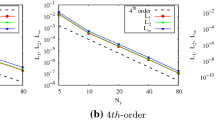Abstract
Central-difference and upwind schemes of approximating convective terms of the gas dynamics equations and their interaction carried out using various transition and weight functions are considered. Testing is carried out on a model problem of the decay of homogeneous isotropic turbulence. Methods of large eddies with closing turbulence models are considered. The question of the consistency of the initial field with respect to the parameters of the turbulence model is investigated. The optimal values of the constants of the closing turbulence model are determined, which allow, in the case of the central-difference approximation, maintaining a low level of dissipation of the kinetic energy of turbulence in the high-frequency region of its spectrum. The weighting factor of the upwind scheme is determined, starting from which the influence of the mentioned constants becomes insignificant.












Similar content being viewed by others
REFERENCES
A. V. Garbaruk, M. Kh. Strelets, A. K. Travin, and M. L. Shur, Modern Approaches to Turbulence Modeling (Izd. Politekh. Univ., St. Petersburg, 2016) [in Russian].
P. R. Spalart, S. Deck, M. L. Shur, K. D. Squires, M. Kh. Strelets, and A. Travin, “A new version of detached-eddy simulation, resistant to ambiguous grid densities,” Theor. Comput. Fluid Dyn. 20, 181–195 (2006).
A. Travin, M. Shur, M. Strelets, and P. R. Spalart, “Physical and numerical upgrades in the detached-eddy simulation of complex turbulent flow,” in Advances in LES of Complex Flows, Ed. by R. Friedrich and W. Rodi, Fluid Mechanics and Its Applications, Vol. 65 (Springer, Dordrecht, 2002), pp. 239–254.
F. R. Menter, “Two-equation eddy-viscosity turbulence models for engineering applications,” AIAA J. 32, 1598–1605 (1994).
S. Bakhne, S. M. Bosniakov, S. V. Mikhailov, and A. I. Troshin, “Comparison of gradient approximation methods in schemes designed for scale-resolving simulations,” Math. Models Comput. Simul. 12, 357–367 (2020).
S. V. Mikhailov, “Object-oriented approach to the design of efficient programs that implement parallel computation algorithms,” Tr. TsAGI, No. 2671, 86–108 (2007).
S. V. Mikhaylov and V. V. Vlasenko, “ZEUS program for calculating unsteady flows within the RANS and LES approaches,” in Proceedings of the XX school-seminar “Aerodynamics of aircraft,” (Volodarskogo vill., Russia, February 26–27, 2009), pp. 40–41 [in Russian].
S. M. Bosnyakov, “The concept of the EWT-TsAGI software product and the main stages of its development,” Tr. TsAGI, No. 2671, 3–19 (2007).
R. Zhang, M. Zhang, and C.-W. Shu, “On the order of accuracy and numerical performance of two classes of finite volume WENO schemes,” Commun. Comput. Phys. 9, 807–827 (2011).
A. Suresh and H. T. Huynh, “Accurate monotonicity-preserving schemes with Runge–Kutta time stepping,” J. Comput. Phys. 136, 83–99 (1997).
B. van Leer, W.-T. Lee, P. L. Roe, K. G. Powell, and C.-H. Tai, “Design of optimally smoothing multistage schemes for the Euler equations,” Commun. Appl. Numer. Methods 8, 761–769 (1992).
M. S. Gritskevich, A. V. Garbaruk, J. Schütze, and F. R. Menter, “Development of DDES and IDDES formulations for the k-ω shear stress transport model,” Flow, Turbul. Combust. 88 , 431–449 (2012).
M. L. Shur, P. R. Spalart, M. Kh. Strelets, and A. K. Travin, “An enhanced version of DES with rapid transition from RANS to LES in separated flows,” Flow, Turbul. Combust. 95, 709–737 (2015).
B. Etkin, Dynamics of Atmospheric Flight (Wiley, New York, 1972).
D. A. Liubimov, “Analysis of turbulent jet and separated flows in turbojet engine elements by combined RANS/LES-methods of high resolution,” Doctoral Dissertation in Mathematics and Physics (Central Inst. Aviat. Motors, Moscow, 2014).
E. K. Guseva, “Analysis and evaluation of the effectiveness of methods that accelerate the transition to numerically resolved turbulence when using nonzone hybrid approaches to calculating turbulent flows,” Candidate’s Dissertation in Mathematics and Physics (St. Petersburg Polytech. Univ., St. Petersburg, 2017).
B. Fornberg, “Generation of finite difference formulas on arbitrarily spaced grids,” Math. Comput. 51, 699–706 (1988).
J. Fröhlich, C. P. Mellen, W. Rodi, L. Temmerman, and M. A. Leschziner, “Highly resolved large-eddy simulation of separated flow in a channel with streamwise periodic constrictions,” J. Fluid Mech. 526, 19–66 (2005).
Ch. R. Rapp, “Experimentelle Studie der turbulenten Strömung über periodische Hügel,” PhD Thesis (Technische Universität München, 2009).
L. Temmerman, M. A. Leschziner, C. P. Mellen, and J. Fröhlich, “Investigation of wall-function approximations and subgrid-scale models in large eddy simulation of separated flow in a channel with streamwise periodic constrictions,” Int. J. Heat Fluid Flow 24, 157–180 (2003).
Author information
Authors and Affiliations
Corresponding author
Ethics declarations
The authors declare that they have no conflicts of interest.
Rights and permissions
About this article
Cite this article
Bakhne, S. Comparison of Convective Terms’ Approximations in DES Family Methods. Math Models Comput Simul 14, 99–109 (2022). https://doi.org/10.1134/S2070048222010057
Received:
Revised:
Accepted:
Published:
Issue Date:
DOI: https://doi.org/10.1134/S2070048222010057




